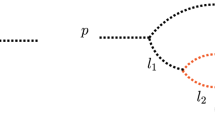Summary
We consider the divergent graphs of quantum electrodynamics and interpret the undefined products of two or more propagators as follows: we first modify the argument of one propagator by adding a small spacelike four-vector of magnitude ɛ; we then compute the integral and average the resulting expression over all angles and, finally, take the limit ɛ=0. In momentum space each diagram turns into the Fourier transform of the usual integrand. The computation of any loop reduces to simple iterated convolution products of the causal delta Δ c (ɛ) by itself. The procedure is fully covariant and the Ward identity is satisfied for all ɛ; however it is not gauge invariant, not even in the limit ɛ=0. This invariance may be recovereda posteriori by renormalizing the photon mass to zero. To show how easily the method works, the electron self-energy diagram in lowest order is explicitly evaluated. The result coincides exactly with the conventional way of handling infinite integrals, both for the finite part and for the ultraviolet and infra-red divergences. Feynman’s auxiliarly massM turns out to be inversely proportional to ɛ.
Riassunto
Si considerano i grafici divergenti dell’elettrodinamica quantistica e si interpretano i prodotti indefiniti di due o più propagatori come segue: prima si modifica l’argomento di un propagatore aggiungendo un piccolo quadrivettore spaziale di grandezza ɛ; poi si calcola l’integrale e si fa la media dell’espressione che ne risulta rispetto a tutti gli angoli ed infine si prende il limite ɛ=0. Nello spazio degli impulsi ciascun diagramma diviene la trasformata di Fourier dell’integrando usuale. Il calcolo di ogni ansa si riduce a semplici prodotti di convoluzione iterati del delta causale Δ c (ɛ) per sé stesso. Il procedimento è completamente covariante e l’identità di Ward è soddisfatta per tutti gli ɛ; tuttavia essa non è invariante di gauge, neanche nel limite ɛ=0. Questa invarianza può essere ricuperataa posteriori normalizzando a zero la massa del fotone. Per mostrare come funzioni facilmente il metodo si valuta esplicitamente il diagramma di autoenergia dell’elettrone nell’ordine inferiore. Il risultato coincide esattamente col metodo convenzionale di trattare integrali infiniti, sia per la parte finita che per le divergenze ultraviolette ed infrarosse. Risulta che la massa ausiliareM di Feynman è inversamente proporzionale ad ɛ.
Реэюме
Мы исследуем расходяшиеся графики квантовой злектродинамики и рассматриваем неопределенные проиэведения двух или более пропагаторов следуюшим обраэом: сначала мы модифицируем вывод для одного пропагатора, добавляя малую пространственно-под обную четырех-векторную величину ɛ; эатем мы вычисляем интеграл и усредняем полученное выражение по всем углам и, наконец, определяем предел при ɛ=0. В импульсном пространстве каждая диаграмма преврашается в Фурье-обраэ обычного подынтегрального выражения. Вычиисление любой петли сводится к простым проиэведениям сверток причинной дельта-функции Δ c (ɛ). Предложенная процедура является полностью ковариантной и тождество Уорда удовлетворяется для всех ɛ; однако, зта процедура не является калибровочно инвариантной, даже в пределе ɛ=0. Эта инвариантность может быть восстановлена «а Постериори» посредством перенормировки массы фотона к нулевому эначению. Чтобы покаэать простоту предложенного метода, в явном виде вычисляется диаграмма собственной знергии злектрона в ниэщем порядке. Полученный реэультат точно совпадает с реэультатом обшепринятого метода рассмотрения неопределенных интегралов. Совпадение имеет место и для конечной части и для ультрафиолетовой и инфракрасной расходимостей. Фейнмановская вспомогательная массаM окаэывается обратно пропорциональна ɛ.
Similar content being viewed by others
References
E. Fermi:Nuclear Physics (Chicago, Ill., 1959), p. 142, 148;J. D. Bjorken andD. Drell:Relativistic Quantum Mechanics, eq. (7.37) (New York, N. Y., 1964).
J. M. Jauch andF. Rohrlich:The Theory of Photons and Electrons (Reading, Mass., 1955).
P. A. M. Dirac:Proc. Roy. Soc.,167 A, 148, (1938), p. 160.
Y. Takahashi:Nuovo Cimento,6, 370 (1957).
C. G. Bollini, J. J. Giambiagi andA. Gonzalez Dominguez:Nuovo Cimento,31, 550 (1964).
N. N. Bogoliubov andD. V. Shirkov:Introduction to the Theory of Quantized Fields (New York, N. Y., 1959), p. 396.
Author information
Authors and Affiliations
Additional information
To speed up publication, the author of this paper has agreed to not receive the proofs for correction.
Rights and permissions
About this article
Cite this article
Lopez, C.A. Convolution regularization in quantum electrodynamics. Nuov Cim A 31, 54–64 (1976). https://doi.org/10.1007/BF02729921
Received:
Published:
Issue Date:
DOI: https://doi.org/10.1007/BF02729921




